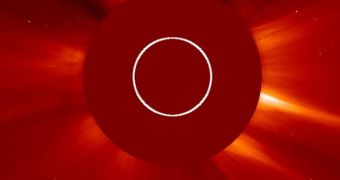This week, scientists with the American space agency saw a relatively large comet strike the Sun, after having spiraled ever closer to the star for a while now. At the same time, they also noticed a huge solar eruption, but the team that made the observations says that the two events are unrelated.
The Sun is now well on its way toward a maximum in its 11-year cycle, which means that it starts to exhibit increasingly-large numbers of sunspots and solar flares, alongside coronal mass ejections (CME) and other related events.
Most likely, the comet's destruction coincided with the new eruption, and there is nothing more to this than meets the eye. Both events were discovered and analyzed using the NASA Solar and Heliospheric Observatory (SOHO).
The spacecraft is dedicated to making solar observations around the clock, and it was the first of all solar telescopes to observe the comet on its destructive path towards the surface of the Sun.
It was consumed by the star between Tuesday, May 10, and Wednesday, May 11. The tremendous heat the star gives off undoubtedly melted all the ice reserves in the loosely-bound comet, and caused it to disintegrate. The scorching heat probably also melted all other materials in the space object.
SOHO also detected a coronal mass ejection (CME) taking place as this happened. Such an event is characterized by an intense plasma burst, which carries with it vast amounts of highly-energetic particles away from the Sun.
During such an event, as much as 10 billion tons of plasma can be released in one go, and the particles that are produced at the same time can travel at speeds of up to 1 million miles per hour, Space reports.
“Interestingly, a coronal mass ejection blasted out to the right just as the comet is approaching the Sun. Scientists, however, have yet to find a convincing physical connection between Sun-grazing comets and coronal mass ejections,” a statement released by SOHO officials on May 13 reads.
The same document highlights the fact that the CME took place long before the doomed comet was close enough to the Sun to cause any real, discernible influence. Data collected by the NASA Solar Dynamics Observatory (SDO) corroborate this with further proof.
“Images from the Solar Dynamics Observatory show that the CME erupted before the comet came close enough to the solar surface to interact with strong magnetic fields,” a press release issued by SDO officials reads.

 14 DAY TRIAL //
14 DAY TRIAL //